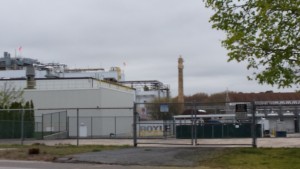 “My cats came in covered in yellow,” one person stated. Another said her mother saw barrels of the Crayola-yellow stuff positioned against the fence that separated the neighborhood of Windsor Park from the Hoechst chemical facility.
“My cats came in covered in yellow,” one person stated. Another said her mother saw barrels of the Crayola-yellow stuff positioned against the fence that separated the neighborhood of Windsor Park from the Hoechst chemical facility.
I posted a shorter version of this story to several Facebook pages dedicated to West Warwick, and I got a ton of reaction, for most of us remember the day(s) when a yellow dust fell from the sky and coated everything, at least in my neighborhood of Crompton.
Something went woefully wrong, for we recall waking up to neon yellow all over hedges, cars, yards. It mimicked an eerie scene from “The Twilight Zone.”
My father who had chemistry/physics background did some checking the next day and told us “nothing harmful happened”—the company had assured him.
Of course, that was before all of us of a certain age recall Love Canal in New York where the Hooker Chemical Company gave similar assurances to its neighbors.
In the summer, during a dry spell, kids playing on the athletic fields were suddenly ankle-deep in sludge rising from below, wicking its way up through the ground, a chemical wash that was toxic indeed. Next it was found coming through basement walls, all owing to the way Hooker was indiscriminately disposing of its toxic waste, sending it out, onto the land where it filtered down, creating an underground plume that knew no bounds.
As a result of the suspected poisoning, there was a virtual abandonment of the community and inability for homeowners to sell but a greater toll remained: cancer cluster groups developed and people succumbed at a far more alarming rate than was average.
It was a lesson for all of us in mill towns across America.
Nine years ago, my husband and I zeroed in on the idyllic community of Asheville, North Carolina, a town set in the Blue Ridge Mountains, on everyone’s short list of preferred retirement communities. With that, we went on a shopping spree, with a buyer broker realtor, to identify our home.
There, sitting at the top of a gorgeous expanse of mountains, was a home we could love…if not for the two factories below. One sprawling building was defunct and I knew that would predict dire consequences in future when upkeep would become non-existent. It would crumble and decay and become an eyesore on the otherwise pristine horizon.
The other factory was still active, suggesting worse problems. A pond nearby had signs posted “No swimming…no fishing.”
My husband, a good ol’ boy from rural Arkansas (where there were no factories or industrial waste), suspected the admonition was due to the fact there was no lifeguard and the company didn’t wish to be liable, while I believed otherwise. Then again, he’s the one who asked if the trout on the menu at a North Carolina restaurant in a small local town was ‘from a nearby stream’ to which the waitress answered “No, it’s farm trout. You wouldn’t want fish from a nearby stream.” She knew what he didn’t know.
Outside the town of Asheville sits an upscale housing community of homes priced at $500,000+, which has painfully learned the lessons mill town residents know for, at present, a toxic underground plume grows and creeps towards them, affecting a nearby stream, air, and well water. It comes from an abandoned former metal plating factory nearby.
Their home value has plummeted; they cannot sell; they cannot leave.
Their retirement dream has turned to a nightmare.
In my book, “The Asheville Experiment” I show how I protected us against the possibility of buying in an out-of-state community whose toxic dump sites we couldn’t know.
But it is my heritage as a mill town girl, coupled with my training as a professional realtor, that taught me such.
For that, I am grateful.
West Warwick native, Colleen Kelly Mellor (ckmellor@cox.net), is a motivational speaker, freelance writer, and author to children’s books Grandpa and the Truck (grandpaandthetruck.com). She is also a regular commentator in the Providence Journal and the Kent County Daily Times. She currently completes “The Asheville Experiment,” about her husband’s and her nine years in the trendy retirement town of Asheville, NC.
She’ll also tell why they returned to live in Rhode Island (This book’s a manual for all those who contemplate a move–anywhere– but who like their non-fiction laced with humor.)
